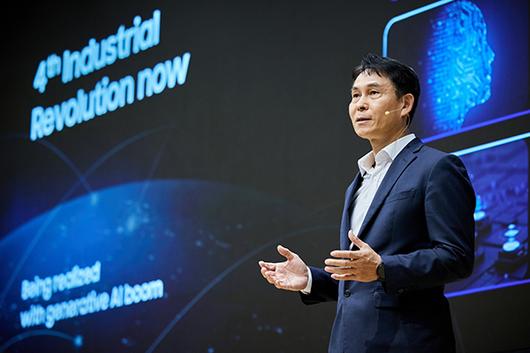 |
Park Yong-in, Samsung Electronics’ president who also leads the System LSI Division, is delivering a speech. [Courtesy of Samsung Electronics] |
<이미지를 클릭하시면 크게 보실 수 있습니다> |
South Korean tech giant Samsung Electronics Co. unveiled its next-generation mobile application processor (AP) equipped with the latest graphics and generative AI technology on Thursday local time in Silicon Valley, United States.
The company held the “Samsung System LSI Tech Day 2023” at its U.S. headquarters in Silicon Valley, California, and showcased the Exynos 2400, which incorporates all the latest system semiconductor technologies.
The Exynos 2400 is a next-generation mobile AP equipped with the Xclipse 940 graphic processing unit (GPU) based on RDNA3, the latest architecture from U.S. chipmaker American Micro Devices, Inc.
Compared to its predecessor Exynos 2200, the latest version has significantly enhanced the central processing unit (CPU) performance by 1.7 times and artificial intelligence (AI) performance by 14.7 times to maximize user experience, according to Samsung Electronics.
The company plans to provide the best user experience for high-performance game players by applying advanced graphics technologies to the AP such as ray tracing, which tracks light, as well as reflection and shadow rendering, which enables the expression of light reflections and shadow boundaries similar to the real world.
In early 2022, Samsung Electronics launched the Exynos 2200, becoming the first company in the industry to include ray tracing in hardware, providing a console-level gaming experience.
The company introduced a new generative AI technology that converts text into images by installing the Exynos 2400 in its next-generation smartphones.
It also unveiled Zoom Anywhere, a specialized ultra-high-resolution zoom-in technology based on a 20-megapixel image sensor.
This technology can simultaneously capture full-screen and up to 4-times zoom shots of moving objects without degrading image quality. AI technology automatically tracks the objects during close-ups.
Various next-generation system semiconductor technologies, including the Exynos Auto, ISOCELL Auto, and ISOCELL Vision, as well as processors for automotive infotainment, were also on display.
A video showcased how the Exynos Auto V920, a next-generation premium in-vehicle infotainment (IVI) processor scheduled for mass production in 2025, works.
It offers 1.7 times greater CPU performance and a smart and enjoyable mobility experience by connecting a maximum of six high-definition displays simultaneously, Samsung Electronics said.
The company also showcased its safe driving technology through the ISOCELL Auto, an in-car image sensor, and the ISOCELL Vision, which accurately and instantly captures objects’ fast movements.
Samsung Electronics’ goal is to develop semiconductors that can act as taste and smell sensors, which are currently not implemented by semiconductors, out of the five senses of taste, smell, hearing, sight, and touch.
Park Yong-in, Samsung Electronics’ president who also leads the System LSI Division, delivered a keynote speech on the topic of “System LSI Humanoid,” a sensor-based semiconductor that mimics the five human senses, and shared the achievements of the past year, along with the tech vision for system semiconductor design.
“Generative AI is the most important technology trend this year, and there is a growing need to secure more advanced foundational technologies,” Park said. “We will open an era of ‘proactive AI,’ a more advanced form than generative AI, by implementing high-performance internet protocol (IP), long and short-range communication solutions, and System LSI Humanoid.”
이 기사의 카테고리는 언론사의 분류를 따릅니다.
기사가 속한 카테고리는 언론사가 분류합니다.
언론사는 한 기사를 두 개 이상의 카테고리로 분류할 수 있습니다.
언론사는 한 기사를 두 개 이상의 카테고리로 분류할 수 있습니다.


